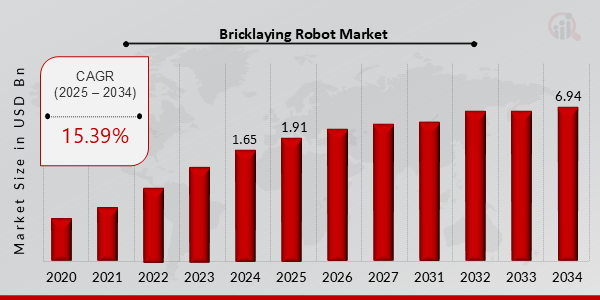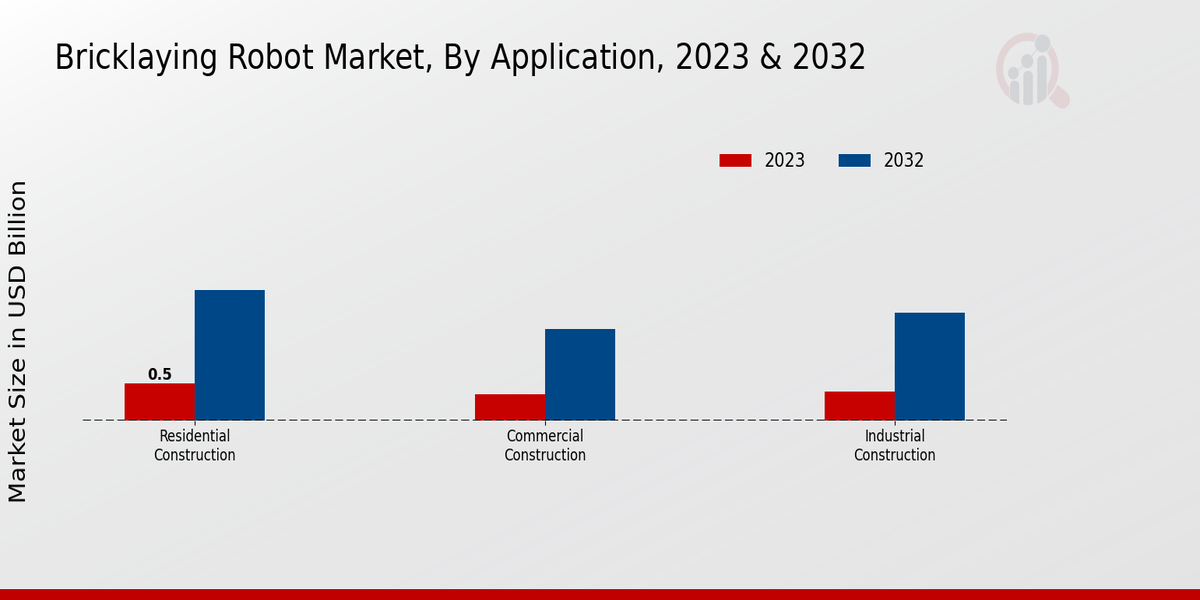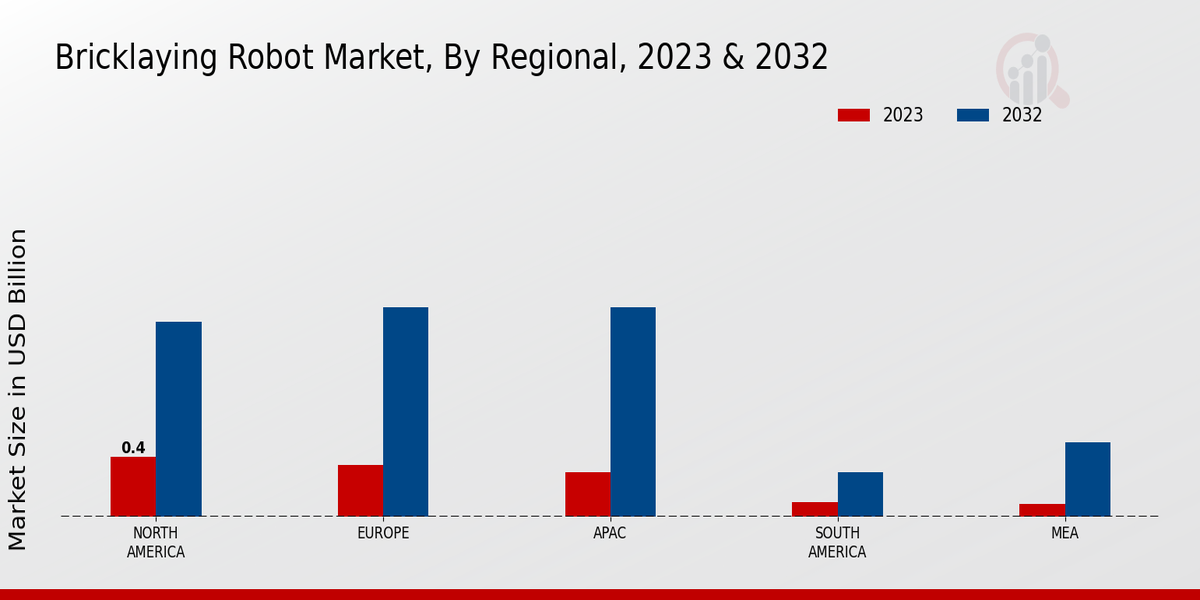Global Bricklaying Robot Market Overview
Bricklaying Robot Market Size was estimated at 1.65 (USD Billion) in 2024. The Bricklaying Robot Market Industry is expected to grow from 1.91 (USD Billion) in 2025 to 6.94 (USD Billion) till 2034, exhibiting a compound annual growth rate (CAGR) of 15.39% during the forecast period (2025 - 2034).
Key Bricklaying Robot Market Trends Highlighted
The Bricklaying Robot Market is being driven by a growing demand for construction automation and a shortage of skilled labor. As construction projects become more complex and timelines shrink, there is a pressing need for efficient and precise building solutions. The adoption of bricklaying robots enhances productivity by allowing for faster construction processes while ensuring consistent quality, thus attracting interest from contractors and construction companies aiming to remain competitive. The push for sustainability in the construction sector is also a vital driver, as these robots can help minimize material waste and optimize resource use, aligning with global sustainability goals.Opportunities in the market are abundant, particularly in expanding markets where infrastructure development is a priority. Emerging regions are increasingly investing in advanced construction technologies to modernize their building practices. Integrating artificial intelligence and machine learning into bricklaying robots presents a further opportunity, allowing for smarter, adaptive building techniques that can learn from previous projects and adjust operations in real-time.
The potential for custom-built solutions tailored to specific building designs also represents a significant avenue for growth, catering to unique architectural needs.Recent times have seen a surge in interest in automated construction technologies due to the pandemic and the resulting focus on worker safety and efficiency. The increasing collaboration between technology companies and construction firms is fostering innovative designs and advanced functionalities in bricklaying robots. Additionally, improved funding for research and development is aiding the industry, prompting advancements in robot capabilities. As the market continues to evolve, the integration of advanced technology, coupled with a response to labor shortages, positions the bricklaying robot segment for sustained growth and relevance in the construction industry.

Source: Primary Research, Secondary Research, MRFR Database and Analyst Review
Bricklaying Robot Market Drivers
Increasing Labor Shortages in Construction Industry
The Bricklaying Robot Market Industry is witnessing significant growth due to the increasing labor shortages in the construction industry. As the construction sector expands, there is a growing demand for skilled labor, particularly in bricklaying, where workers with the necessary expertise are becoming increasingly scarce. This shortage has led construction companies to explore automation technologies, such as bricklaying robots, that can efficiently handle the labor-intensive tasks traditionally performed by human workers.By adopting these advanced robotic systems, companies can streamline their operations, minimize delays, and improve overall project timelines. Additionally, as the workforce demographics shift, with many experienced workers retiring and fewer younger individuals entering this line of work, the reliance on robotic solutions is set to increase. Consequently, the Bricklaying Robot Market is positioned for significant expansion as firms aim to optimize their construction processes amidst these labor challenges.
Technological Advancements in Robotics
The Bricklaying Robot Market Industry is being propelled by continuous technological advancements in robotics and automation. Innovations in artificial intelligence, machine learning, and computer vision have significantly enhanced the capabilities of bricklaying robots. These advanced technologies allow robots to not only perform precise bricklaying tasks but also to adapt to varying conditions on construction sites. This adaptability ensures high quality in work output and efficiently tackles complexities associated with different architectural designs.As technology matures and becomes more cost-effective, many construction companies are expected to integrate these robotic solutions, further driving growth in the market.
Growing Emphasis on Speed and Efficiency
Another crucial driver for the Bricklaying Robot Market Industry is the growing emphasis on speed and efficiency in construction projects. As competition intensifies, construction companies are under pressure to deliver projects faster while maintaining quality standards. Bricklaying robots can significantly accelerate the construction process by completing tasks at a much higher speed compared to manual labor. This capability not only reduces project timelines but also minimizes labor costs in the long run.Furthermore, the ability to maintain consistency in work quality enables companies to enhance their reputations, attract new clients, and secure more contracts. As such, the need for enhanced speed and efficiency is driving the adoption of bricklaying robots in construction activities.
Bricklaying Robot Market Segment Insights
Bricklaying Robot Market Application Insights
The Bricklaying Robot Market heavily relies on diverse Applications, such as Residential Construction, Commercial Construction, and Industrial Construction. In 2023, the overall market is valued at 1.24 USD Billion and is set to experience significant growth, with projections for each application segment demonstrating varied but robust potential. The Residential Construction Application accounts for a valuation of 0.5 USD Billion in 2023, growing to 1.78 USD Billion in 2032, indicating its dominance within the market due to the continuous demand for housing and the need for efficient construction methods. This segment serves as a major driving force in the Bricklaying Robot Market revenue, as home builders increasingly adopt automation to respond to labor shortages and rising construction costs.On the other hand, the Commercial Construction Application is valued at 0.35 USD Billion in 2023 and is expected to rise to 1.25 USD Billion by 2032. While this segment holds a smaller share compared to Residential Construction, it is gaining traction due to the increasing complexity of commercial buildings which require precision and efficiency in bricklaying processes.
Organizations are recognizing the advantages of deploying bricklaying robots to expedite projects and minimize errors, thus enhancing project timelines and overall profitability.Industrial Construction, valued at 0.39 USD Billion in 2023, is expected to grow to 1.47 USD Billion in 2032. This segment also plays a significant role in shaping the Bricklaying Robot Market data as industries seek to build larger structures with higher accuracy and speed. The upward trajectory of this segment can be attributed to the growing need for manufacturing plants and warehouses, which often demand specialized bricklaying due to spatial configurations and technical requirements.As these applications evolve, market trends show a consistent shift towards automation, facilitating labor efficiency, and quality improvements in construction practices.
Challenges such as the initial investment cost and the requirement for skilled operators are present, but they are outweighed by the productivity gains and precision offered by bricklaying robots. The Bricklaying Robot Market statistics reveal that the combined application growth signifies lucrative opportunities as market players innovate to streamline processes and develop advanced robotic solutions tailored specifically for these construction environments. The robust growth outlook across all segments, driven by their respective demands, highlights the critical importance of the Applications within the bricklaying robot landscape.

Source: Primary Research, Secondary Research, MRFR Database and Analyst Review
Bricklaying Robot Market End Use Insights
The Bricklaying Robot Market is expected to garner significant attention from various end-use segments. In 2023, the overall market is valued at 1.24 billion USD, reflecting a growing interest in automation within the construction industry. Masonry contractors are increasingly adopting bricklaying robots to enhance precision and efficiency, addressing labor shortages and rising costs. Construction companies also play an essential role, as they seek to streamline their operations and achieve faster build times while maintaining quality. Additionally, DIY homeowners demonstrate a keen interest in utilizing robotic assistance to tackle personal construction projects, making complex tasks more manageable.As these segments evolve, the Bricklaying Robot Market revenue is projected to reach 4.5 billion USD by 2032, influenced by trends such as technological advancements and the push for sustainable construction practices. The Bricklaying Robot Market statistics underline the importance of these end uses, highlighting their contributions to market growth and emphasizing the need for further innovation within the industry, as challenges like labor costs and efficiency pressures persist. The burgeoning interest from these key players presents ample opportunities for enhanced adoption and market expansion.
Bricklaying Robot Market Robot Type Insights
The Bricklaying Robot Market is witnessing substantial growth, with a market value of 1.24 billion USD as of 2023. This sector encompasses various Robot Type categories, including Automated Bricklaying Robots, Semi-Automated Bricklaying Robots, and Robotic Bricklaying Arms. Automated Bricklaying Robots are gaining traction due to their ability to significantly enhance productivity and precision in construction projects, which is critical in speeding up build timelines and reducing labor costs. Meanwhile, Semi-Automated Bricklaying Robots offer a balance between human expertise and robotic efficiency, allowing for adaptive operations that utilize both technology and skilled labor effectively.Robotic Bricklaying Arms are often favored for their versatility in handling complex tasks in unique environments, thereby providing significant advantages in various construction settings. The Bricklaying Robot Market segmentation highlights the shift towards more advanced and reliable technologies in the construction industry, driven by the demand for automation and efficiency improvements. As the market evolves, the focus on integrating innovation with traditional bricklaying practices is expected to shape the industry positively while addressing labor shortages and increasing project demands.
Bricklaying Robot Market Sales Channel Insights
The Bricklaying Robot Market has shown promising growth in the Sales Channel segment, with an expected market valuation of 1.24 billion USD in 2023, projected to reach 4.5 billion USD by 2032. This segment is crucial in defining how bricklaying robots reach customers, with various channels influencing purchasing decisions and market dynamics. Direct Sales channels play a key role, fostering close relationships between manufacturers and end-users, ensuring that buyers receive tailored solutions. The Distributors channel remains significant as it effectively widens the market reach, allowing for broader penetration in diverse regions.Meanwhile, Online Sales are increasingly popular, driven by the convenience of e-commerce platforms, providing customers with easy access to a variety of options. This flexibility has contributed to the growing interest in bricklaying robots, showcasing the importance of a diversified sales approach in reaching different buyer segments. Market trends indicate that a balanced combination of these channels will support the ongoing expansion observed within the Bricklaying Robot Market. As such, understanding the dynamics of Sales Channels will be essential for stakeholders aiming to capitalize on opportunities in this rapidly evolving industry.
Bricklaying Robot Market Regional Insights
The Bricklaying Robot Market revenue is currently valued at 1.24 USD Billion and is poised for significant growth across various regions. North America holds a notable position with a market value of 0.4 USD Billion, expected to reach 1.3 USD Billion by 2032, indicating its strong adoption of automation technologies in construction. Europe closely follows, valued at 0.35 USD Billion in 2023, transitioning to 1.4 USD Billion by 2032, showcasing a growing interest in labor efficiency. The APAC region is also emerging as a key player with an initial value of 0.3 USD Billion and a forecasted growth to 1.4 USD Billion, reflecting substantial investments in construction robotics.South America, while smaller with a valuation of 0.1 USD Billion, is set to grow to 0.3 USD Billion, highlighting the region's potential for future developments in the construction industry. Meanwhile, the MEA region starts at 0.09 USD Billion in 2023 and is expected to ascend to 0.5 USD Billion, showcasing increasing opportunities in automation. Collectively, these segments reflect diverse market dynamics, driven by demand for labor-saving solutions and technological advancements in bricklaying processes.

Source: Primary Research, Secondary Research, MRFR Database and Analyst Review
Bricklaying Robot Market Key Players and Competitive Insights
The Bricklaying Robot Market is experiencing a transformative phase as advancements in automation technology intersect with the construction industry. With increasing demand for efficiency, quality, and labor cost savings, bricklaying robots are becoming an integral part of construction processes. The competitive landscape is characterized by the presence of established players alongside new entrants aiming to innovate and capture market share. Key factors influencing competition include technological advancements, partnerships, and the ability to adapt to project requirements. Companies that can leverage cutting-edge technology and demonstrate effective solutions for both large-scale and intricate construction projects are positioning themselves favorably in this evolving market.Sika has established a notable presence within the Bricklaying Robot Market, leveraging its expertise in construction materials and technology solutions. The company has gained a reputation for delivering high-performance products that enhance durability and efficiency in construction. Sika's strong research and development capabilities enable it to advance bricklaying robot technology, focusing on integrating innovative materials with automation.
Furthermore, Sika's extensive distribution network allows for consistent availability of its solutions across different markets, enhancing customer reach and engagement. By investing in advanced automation solutions, Sika is not only improving the quality of bricklaying processes but is also positioned as a leader in addressing the pressing needs of modern construction.Toyota Industries Corporation is also carving a significant niche in the Bricklaying Robot Market, utilizing its robust engineering foundation and commitment to innovation. Specialized in manufacturing automation solutions, Toyota Industries Corporation benefits from its vast experience in industrial robotics and a deep understanding of manufacturing processes. The incorporation of sophisticated robotic systems into bricklaying applications reflects Toyota's emphasis on quality, precision, and efficiency. By fostering partnerships with construction firms and enhancing its automation technologies, Toyota Industries Corporation aims to refine bricklaying techniques, optimize workflow, and address the growing demand for skilled labor in the industry. The strategic focus on developing versatile and scalable solutions further exemplifies Toyota's vision of shaping the future landscape of construction automation.
Key Companies in the Bricklaying Robot Market Include
- Sika
- Toyota Industries Corporation
- Fastbrick Robotics
- Construction Robotics
- Robot Systems
- Apis Cor
- ZEN Robotics
- FANUC
- NCC Group
- Revolution Robotics
- Liebherr
- Samsung Heavy Industries
- KUKA
- Voodoo Manufacturing
Bricklaying Robot Industry Developments
The Bricklaying Robot Market is witnessing significant advancements with ongoing innovations and developments by key players such as Fastbrick Robotics and Construction Robotics, who are enhancing automation in construction processes. Companies like Sika and Liebherr are also focusing on integrating robotics with advanced materials to improve the overall efficiency of bricklaying. Meanwhile, Apis Cor and ZEN Robotics are pushing the boundaries of automated construction solutions, emphasizing sustainability and precision in their offerings. Current market dynamics show a growing demand for robotics capable of addressing labor shortages in the construction industry, intensifying competition among stakeholders.Recent mergers and acquisitions have sparked interest within the sector; however, notable consolidation activities remain scarce. Companies like KUKA and FANUC are strategically aligning their robotic technologies for construction applications, showing positive growth in market valuation. Meanwhile, Toyota Industries Corporation's ventures into automated construction continue to shape their portfolio significantly. These developments signal a robust interest in enhancing productivity and sustainability within the bricklaying process, making automation increasingly vital in addressing contemporary construction challenges.
Bricklaying Robot Market Segmentation Insights
Bricklaying Robot Market Application Outlook
- Residential Construction
- Commercial Construction
- Industrial Construction
Bricklaying Robot Market End Use Outlook
- Masonry Contractors
- Construction Companies
- DIY Homeowners
Bricklaying Robot Market Robot Type Outlook
- Automated Bricklaying Robots
- Semi-Automated Bricklaying Robots
- Robotic Bricklaying Arms
Bricklaying Robot Market Sales Channel Outlook
- Direct Sales
- Distributors
- Online Sales
Bricklaying Robot Market Regional Outlook
- North America
- Europe
- South America
- Asia Pacific
- Middle East and Africa
|
Report Attribute/Metric
|
Details
|
|
Market Size 2024
|
USD 1.65 Billion
|
|
Market Size 2025
|
USD 1.91 Billion
|
|
Market Size 2034
|
USD 6.94 Billion
|
|
Compound Annual Growth Rate (CAGR)
|
15.39% (2025-2034)
|
|
Base Year
|
2024
|
|
Market Forecast Period
|
2025-2034
|
|
Historical Data
|
2020-2023
|
| Market Forecast Units |
USD Billion |
| Key Companies Profiled |
Sika, Toyota Industries Corporation, Fastbrick Robotics, Construction Robotics, Robot Systems, Apis Cor, ZEN Robotics, FANUC, NCC Group, Revolution Robotics, Liebherr, Samsung Heavy Industries, KUKA, Voodoo Manufacturing |
| Segments Covered |
Application, End Use, Robot Type, Sales Channel, Regional |
| Key Market Opportunities |
Increased construction automation demand, Labor shortages in construction industry, Rising labor costs globally, Advancements in robotic technology, Sustainable construction practices integration |
| Key Market Dynamics |
Increasing labor shortages, Rising construction automation, High demand for precision, Growing focus on safety, Technological advancements in robotics |
| Countries Covered |
North America, Europe, APAC, South America, MEA |
Frequently Asked Questions (FAQ) :
The Bricklaying Robot Market is expected to be valued at approximately 1.91 USD Billion in 2025.
The market is expected to grow at a CAGR of 15.39% from 2025 to 2034.
By 2032, the Bricklaying Robot Market is projected to reach a valuation of 4.5 USD Billion.
The Residential Construction application segment holds the largest market share, valued at 0.5 USD Billion in 2023.
The Commercial Construction segment is expected to reach a value of 1.25 USD Billion by 2032.
The Industrial Construction segment was valued at 0.39 USD Billion in 2023.
In 2032, the market size for North America is projected to be 1.3 USD Billion.
The APAC region is expected to achieve a market size of 1.4 USD Billion by 2032.
Key players include Sika, Fastbrick Robotics, Construction Robotics, and KUKA among others.
The market value for South America is expected to reach 0.3 USD Billion by 2032.

















